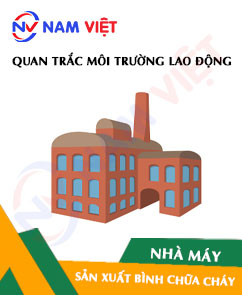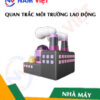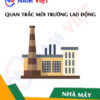Occupational environment monitoring at the factory producing fire extinguishers
99,000 ₫
Note: The above price is calculated for one sample, the price may fluctuate depending on the area of the environment to be monitored and the movement of the market. For more accurate price support, please refer to the quotation table or contact directly with our consulting staff.
Environmental monitoring of fire extinguisher manufacturing factories is a session of collecting, analyzing, and evaluating factors in the workplace that may be harmful to the health of workers.
Table of Contents
Toggle1. Overview of Fire Extinguisher Production Factories
a. What is a fire extinguisher production factory?
A production factory for fire extinguishers is a specialized manufacturing facility designed to produce various types of fire extinguishers, also known as fire suppression devices. Fire extinguishers are essential equipment for handling fires and ensuring safety in case of fire incidents.
In a fire extinguisher production factory, production processes and procedures are carried out to produce high-quality fire extinguishers that meet necessary safety standards.

b. Production stages in a fire extinguisher production factory
The production stages in a fire extinguisher production factory typically include:
- Material preparation: Collecting and preparing raw materials needed for producing fire extinguishers, including fire-resistant materials, cylinder bodies, valves, control units, nozzles, extinguishing powder, and other components.
- Cylinder body processing: Processing the cylinder bodies using methods such as metalworking (cutting, welding, casting), plastic processing (molding, casting, machine processing) to create the desired shape and size for each type of fire extinguisher.
- Fire extinguisher assembly: Assembling components such as valves, control units, nozzles, pumps, extinguishing powder, and other parts. Assembly steps may involve the use of appropriate machinery and tools.
- Inspection and testing: Conducting quality control and safety testing of fire extinguishers after assembly. This includes pressure testing, material quality inspection, functional performance, and other technical requirements to ensure compliance with safety standards.
- Packing and labeling: Completed fire extinguishers are packed and labeled according to regulations. This includes protective packaging, user instructions, manufacturer information, barcodes, production dates, and other essential information.
- Transportation and storage: Fire extinguishers are transported to destinations or distributors for delivery to end-users. Safety regulations and procedures must be followed during transportation and storage to prevent damage or hazards.

c. Machinery used in fire extinguisher production factories
Common machinery used in fire extinguisher factories includes:
- Metal cutting and processing machines: Used to cut and process metal components such as cylinder bodies, valves, pipes, and other parts.
- Welding machines: Used to weld metal joints during cylinder assembly and processing.
- Plastic molding machines: Used to mold plastic components such as valves, caps, and other plastic parts.
- Plastic pressing machines: Used to press plastic into desired shapes and sizes for components.
- Surface processing machines: Used for surface treatment, including grinding, polishing, and painting.
- Pressure testing machines: Used to check cylinder pressure after assembly and ensure compliance with safety standards.
- Printing and labeling machines: Used to print and attach essential information, including manufacturer name, instructions, barcode, and other details.
- Packing machines: Used to pack fire extinguishers and protect them during transport and storage.

d. Occupational diseases for workers in fire extinguisher production factories
Workers in fire extinguisher production factories may be exposed to environmental factors that can cause occupational diseases. Common occupational diseases include:
- Respiratory diseases: Exposure to chemical compounds, dust, fumes, toxic vapors, and gases during production can cause pneumonia, sinusitis, tonsillitis, and laryngitis.
- Skin diseases: Contact with chemicals can cause skin irritation, allergies, dermatitis, and burns.
- Cardiovascular diseases: Tasks involving heavy machinery, high-temperature environments, high pressure, or high workload can contribute to hypertension, coronary artery disease, and stroke.
- Musculoskeletal disorders: Repetitive tasks such as packing, transporting, and assembly can lead to arthritis, joint degeneration, and work-related injuries.
- Nervous system disorders: Exposure to toxic chemicals may cause tremors, muscle spasms, and central nervous system issues.
- Cardiovascular risks due to noise and stress: Loud working environments, high work pressure, and stress can lead to hypertension, myocardial infarction, and arrhythmia.
To ensure worker safety, fire extinguisher production factories must comply with occupational safety regulations, provide personal protective equipment, maintain safe working procedures, and provide occupational health and safety training.

e. Common types of fire extinguishers on the market
Common types of fire extinguishers include:
- Powder extinguishers: Use extinguishing powders (such as ABC powder, BC powder) to put out fires. Suitable for fires involving solids, liquids, and gases.
- CO2 extinguishers: Use compressed carbon dioxide to suppress fires by displacing oxygen at the fire source.
- Foam extinguishers: Use foam (such as AFFF, AR-AFFF) to form a barrier over the fire, preventing contact with oxygen.
- Water extinguishers: Use water to cool and extinguish fires. Suitable for fires involving solids and liquids.
- Dry chemical extinguishers: Use dry chemical agents (such as diammonium phosphate, ammonium chloride) to extinguish fires.
- Steam extinguishers: Use water vapor to cool and suppress fires.
2. Overview of Occupational Environmental Monitoring Services
a. What is occupational environmental monitoring in fire extinguisher production factories?
Occupational environmental monitoring (or workplace environment measurement) in fire extinguisher factories involves collecting, evaluating, and analyzing environmental factors in the workplace to implement timely measures, minimize health risks for workers, and prevent occupational diseases. This monitoring is mandatory for fire extinguisher production factories.
Occupational environmental monitoring is crucial for protecting and improving workers’ health, as workers are the main resource of a business and directly generate profit. Employees frequently exposed to hazards above permissible limits are at risk of occupational diseases.
REGISTER FOR OCCUPATIONAL ENVIRONMENT MONITORING SERVICE
b. Nam Toan Viet’s occupational environmental monitoring program
Nam Toan Viet’s program is designed by monitoring engineers specializing in labor safety and environmental protection. Aimed at ensuring health and safety, it uses modern measurement methods to monitor air quality, water, microclimate, physical factors, dust, and more within the workplace. This program is crucial for ensuring a safe working environment and protecting employee health.
Additionally, the program supports research and development of new solutions to improve workplace environmental quality. With the professionalism of the monitoring experts, Nam Toan Viet’s exclusive program is a breakthrough in occupational safety management and environmental protection in Vietnam.

c. Standardization in workplace environmental measurement
Standardization in Nam Toan Viet’s measurement process ensures accurate and reliable results, following recognized standards of the Ho Chi Minh City Department of Health. This guarantees that collected data is reliable for evaluating workplace conditions and making informed decisions to protect workers’ health.
Standardized procedures also ensure measurements are conducted by a highly skilled monitoring team, allowing managers to trust the results and make accurate decisions for health and environmental protection.
By applying standardized procedures, Nam Toan Viet demonstrates its commitment to a safe workplace and contributes to improving occupational safety management and environmental protection in Vietnam.
d. Reporting monitoring results for fire extinguisher factories
Monitoring results are prepared according to Form No. 04, Appendix III issued with Decree 44/2016/ND-CP and prepared in two copies: one for the workplace that contracted the monitoring service, and one kept by the monitoring organization.
Records must be stored indefinitely according to legal regulations.

e. Frequency of occupational environmental monitoring as required by law
According to Clause 2, Article 18 of the Law on Occupational Safety and Hygiene 84/2015/QH13, employers must conduct occupational environmental monitoring at least once a year.
f. Deadline for submitting monitoring reports
Reports must be submitted by December 31 each year. Production factories must submit reports to the local Department of Health where the headquarters is located and where employees are working.
When changes in technology, production processes, or facility upgrades introduce new hazards, factories must update occupational hygiene records to include harmful factors requiring monitoring.
g. Penalties for violations of occupational environmental monitoring by employers
According to Article 27 of Decree No. 12/2022/ND-CP dated January 17, 2022:
- Clause 2: Fines of VND 2,000,000 – 5,000,000 for employers who fail to publicly disclose monitoring results to employees immediately after obtaining them.
- Clause 3: Fines of VND 20,000,000 – 40,000,000 for employers who fail to conduct monitoring as required by law.
- Clause 4: Fines of VND 40,000,000 – 60,000,000 for employers who collude with monitoring organizations to falsify results, without reaching criminal liability.
3. Harmful Environmental Factors for Workers in Fire Extinguisher Production Factories
There are several environmental factors that may harm workers in fire extinguisher production factories. Here are some examples:
- Chemicals: During the production of fire extinguishers, chemicals and additives such as fire extinguishing powder, compressed gases, anti-rust agents, sealants, and filler materials may be used. These chemicals can be harmful if there is direct contact or inhalation.
- Dust and fine particles: The processing and production of fire extinguishers can generate dust and fine particles. Inhalation of these dust and particles may irritate or damage the respiratory system and other parts of the body.
- Noise: Some machinery and processes in fire extinguisher production factories can produce high noise levels. Continuous and loud noise can affect hearing, cause stress, and negatively impact workers’ overall health.
- Temperature and pressure: The production and testing of fire extinguishers may involve high temperatures and high pressure. Exposure to high temperature and pressure can cause burns, skin damage, and other health issues.
- Air obstruction: During fire extinguisher production, air obstruction may occur due to emissions from machinery and production processes. Air obstruction can cause breathing difficulties, respiratory irritation, and affect workers’ health.
REGISTER FOR WORKPLACE ENVIRONMENT MONITORING SERVICE
4. Measures to Improve the Working Environment in Fire Extinguisher Production Factories
To improve the working environment in fire extinguisher production factories and protect workers’ health, the following measures can be applied:
- Chemical management: Ensure that the use, storage, and handling of chemicals are carried out according to safety regulations. Ensure employees are trained on proper chemical handling and provided with appropriate personal protective equipment.
- Control of dust and fine particles: Design effective ventilation systems to remove dust and fine particles during production. Ensure employees are provided with protective equipment such as masks to safeguard their respiratory system.
- Noise management: Implement noise control measures such as isolating noisy machinery, using soundproof materials, and providing ear protection for employees working in noisy environments.
- Temperature and pressure management: Ensure safety when working with high temperatures and high pressure. Provide protective equipment such as heat-resistant clothing, gloves, and helmets to protect employees from burns.
- Air management: Ensure production processes and exhaust systems are effectively controlled. Provide air purification measures such as filtration, dust extraction, and ventilation to minimize air obstruction and impact on workers’ health.
- Training and education: Train employees on safety rules, proper working procedures, and the correct use of personal protective equipment. Enhance education on occupational hazards and preventive measures.
- Risk management: Conduct risk assessments and plan to minimize environmental hazards, ensuring a safe and healthy working environment.
- Regularly conduct workplace environment monitoring in factories, collect and analyze harmful factors affecting workers, and adjust to reduce hazards to prevent occupational diseases.
5. Benefits of Regular Monitoring of Fire Extinguisher Production Factories
An Toan Nam Viet provides excellent benefits to businesses using workplace environment monitoring services according to Decree 44/2016/ND – CP on managing and controlling harmful factors in the working environment affecting workers.
- Businesses can proactively control harmful factors in the factory or production site.
- Receive consultation and recommendations on measures to reduce harmful factors and improve working environment quality.
- Indirectly protect human resources, a key factor in the company’s development process.
- Minimize the impact of occupational diseases on workers’ health, thereby reducing future treatment costs.
- Improve workers’ health, leading to better product quality and maintained production output.
- Comply with labor safety laws, avoiding legal risks.
- Enhance credibility and professionalism in all aspects, elevating the company’s brand.
Nam Viet’s environmental monitoring service is a solution to reduce occupational disease risks, contributing to a clean and high-quality working environment.

6. National Workplace Environment Monitoring Center
Workplace Environment Monitoring Center of Nam Viet is a professional unit for supervising and measuring the quality of workplace environments across all provinces in Vietnam. With a team of experienced monitoring specialists, the center uses modern measuring equipment to ensure accuracy and reliability.
In addition to providing monitoring services, the center supports clients in planning, managing, and following up on workplace environmental issues. Following the motto “customer-centric,” the center prioritizes client satisfaction, meets all customer needs, and commits to providing the best solutions for businesses.
REGISTER FOR WORKPLACE ENVIRONMENT MONITORING SERVICE
With investments in technology, equipment, and human resources, Nam Viet’s monitoring center has become one of the reputable units in workplace environment monitoring in Ho Chi Minh City, with the following objectives:
- We always value brand reputation and the quality of our service products.
- We provide clients with the best and most suitable solutions possible.
- Along with a team of experienced Masters and Engineers, committed to protecting the environment and benefiting businesses.
- By choosing Nam Viet Environmental Monitoring, your company will receive professional service from experts in the field and enjoy the best cost advantages.
The workplace environment monitoring process at Nam Viet includes the following basic steps:
- Before conducting monitoring, we ensure that all machinery and equipment are calibrated and adjusted according to legal regulations.
- Carry out the workplace environment monitoring process as committed to the Department of Health.
- Report workplace environment monitoring results honestly to the employer.
- If the monitoring results do not ensure safety for workers, Nam Viet will support corrective solutions and the workplace will implement:
- Implement measures to improve working conditions to minimize the impact of harmful factors and prevent occupational diseases.
- Organize health checks to detect occupational diseases and related illnesses early for employees in unsafe working conditions.
- Provide in-kind compensation to workers according to labor law regulations.

7. Workplace Environment Monitoring Price List
To help businesses conduct workplace environment monitoring professionally and effectively, Nam Viet provides clients with a comprehensive and reasonably priced monitoring service price list.
- Our price list provides detailed information about the costs of the monitoring services we offer, including travel, measurement, analysis, and reporting. Clients can be fully assured of the accuracy and reliability of the monitoring reports we provide.
- We commit to offering competitive and reasonable prices in the market and are always ready to consult and answer any questions about monitoring services promptly and professionally.
- With Nam Viet’s monitoring price list, clients can easily choose service packages that fit their needs. We commit to delivering the highest satisfaction with professional service quality.
No comments yet












Review Occupational environment monitoring at the factory producing fire extinguishers
There are no reviews yet.